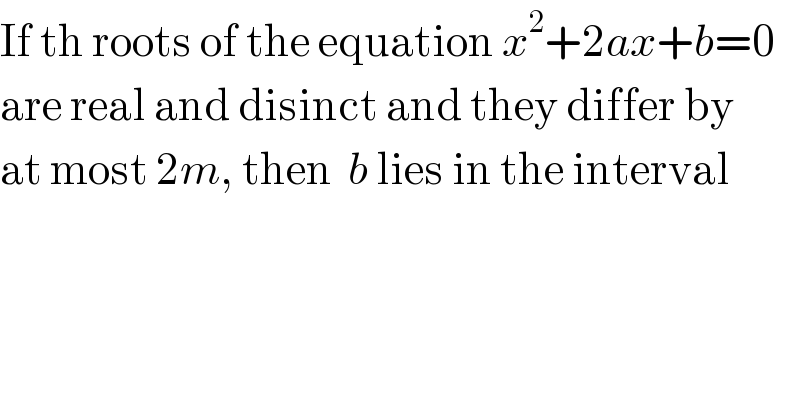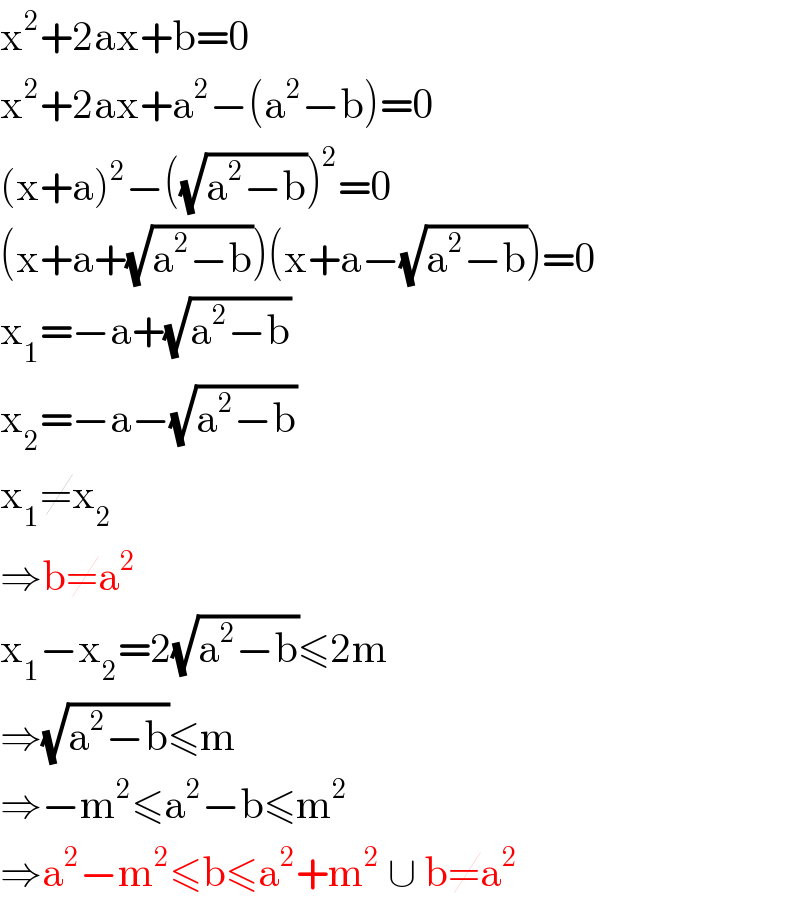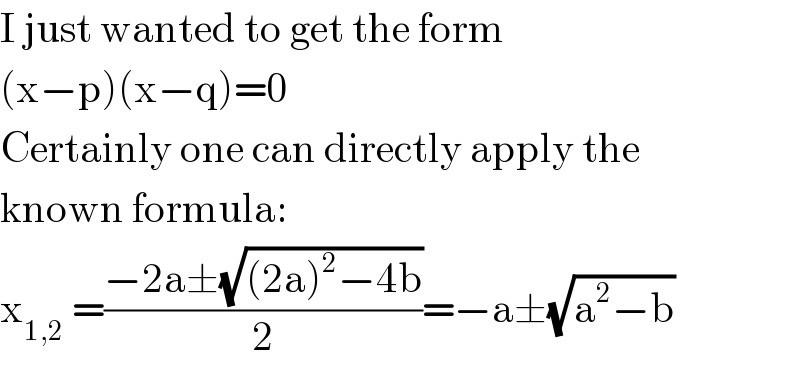
Question Number 21519 by ram1234 last updated on 26/Sep/17

$$\mathrm{If}\:\mathrm{th}\:\mathrm{roots}\:\mathrm{of}\:\mathrm{the}\:\mathrm{equation}\:{x}^{\mathrm{2}} +\mathrm{2}{ax}+{b}=\mathrm{0} \\ $$$$\mathrm{are}\:\mathrm{real}\:\mathrm{and}\:\mathrm{disinct}\:\mathrm{and}\:\mathrm{they}\:\mathrm{differ}\:\mathrm{by} \\ $$$$\mathrm{at}\:\mathrm{most}\:\mathrm{2}{m},\:\mathrm{then}\:\:{b}\:\mathrm{lies}\:\mathrm{in}\:\mathrm{the}\:\mathrm{interval} \\ $$
Answered by mrW1 last updated on 26/Sep/17

$$\mathrm{x}^{\mathrm{2}} +\mathrm{2ax}+\mathrm{b}=\mathrm{0} \\ $$$$\mathrm{x}^{\mathrm{2}} +\mathrm{2ax}+\mathrm{a}^{\mathrm{2}} −\left(\mathrm{a}^{\mathrm{2}} −\mathrm{b}\right)=\mathrm{0} \\ $$$$\left(\mathrm{x}+\mathrm{a}\right)^{\mathrm{2}} −\left(\sqrt{\mathrm{a}^{\mathrm{2}} −\mathrm{b}}\right)^{\mathrm{2}} =\mathrm{0} \\ $$$$\left(\mathrm{x}+\mathrm{a}+\sqrt{\mathrm{a}^{\mathrm{2}} −\mathrm{b}}\right)\left(\mathrm{x}+\mathrm{a}−\sqrt{\mathrm{a}^{\mathrm{2}} −\mathrm{b}}\right)=\mathrm{0} \\ $$$$\mathrm{x}_{\mathrm{1}} =−\mathrm{a}+\sqrt{\mathrm{a}^{\mathrm{2}} −\mathrm{b}} \\ $$$$\mathrm{x}_{\mathrm{2}} =−\mathrm{a}−\sqrt{\mathrm{a}^{\mathrm{2}} −\mathrm{b}} \\ $$$$\mathrm{x}_{\mathrm{1}} \neq\mathrm{x}_{\mathrm{2}} \\ $$$$\Rightarrow\mathrm{b}\neq\mathrm{a}^{\mathrm{2}} \\ $$$$\mathrm{x}_{\mathrm{1}} −\mathrm{x}_{\mathrm{2}} =\mathrm{2}\sqrt{\mathrm{a}^{\mathrm{2}} −\mathrm{b}}\leqslant\mathrm{2m} \\ $$$$\Rightarrow\sqrt{\mathrm{a}^{\mathrm{2}} −\mathrm{b}}\leqslant\mathrm{m} \\ $$$$\Rightarrow−\mathrm{m}^{\mathrm{2}} \leqslant\mathrm{a}^{\mathrm{2}} −\mathrm{b}\leqslant\mathrm{m}^{\mathrm{2}} \\ $$$$\Rightarrow\mathrm{a}^{\mathrm{2}} −\mathrm{m}^{\mathrm{2}} \leqslant\mathrm{b}\leqslant\mathrm{a}^{\mathrm{2}} +\mathrm{m}^{\mathrm{2}} \:\cup\:\mathrm{b}\neq\mathrm{a}^{\mathrm{2}} \\ $$
Commented by Joel577 last updated on 26/Sep/17

$$\mathrm{What}'\mathrm{s}\:\mathrm{the}\:\mathrm{idea}\:\mathrm{so}\:\mathrm{u}\:\mathrm{manipulated} \\ $$$$\mathrm{the}\:\mathrm{equation}\:\mathrm{with}\:\mathrm{adding}\:{a}^{\mathrm{2}} \:−\:{a}^{\mathrm{2}} \:\left(\mathrm{line}\:\mathrm{2}\right)\:? \\ $$
Commented by mrW1 last updated on 26/Sep/17

$$\mathrm{I}\:\mathrm{just}\:\mathrm{wanted}\:\mathrm{to}\:\mathrm{get}\:\mathrm{the}\:\mathrm{form} \\ $$$$\left(\mathrm{x}−\mathrm{p}\right)\left(\mathrm{x}−\mathrm{q}\right)=\mathrm{0} \\ $$$$\mathrm{Certainly}\:\mathrm{one}\:\mathrm{can}\:\mathrm{directly}\:\mathrm{apply}\:\mathrm{the} \\ $$$$\mathrm{known}\:\mathrm{formula}: \\ $$$$\mathrm{x}_{\mathrm{1},\mathrm{2}} \:=\frac{−\mathrm{2a}\pm\sqrt{\left(\mathrm{2a}\right)^{\mathrm{2}} −\mathrm{4b}}}{\mathrm{2}}=−\mathrm{a}\pm\sqrt{\mathrm{a}^{\mathrm{2}} −\mathrm{b}} \\ $$
